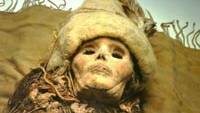World’s Oldest Cheese Found With Mummies
Ah, excellent. Just in time to go with the world’s oldest wine cellar, comes the news of the world’s oldest cheese.Found on the bodies of Iron-Age mummies in northwestern China, the cheese was remarkably preserved due to the conditions of the burial site, as well as the funerary methods of wrapping the bodies tightly in cowhide.
Now we simply need the world’s oldest crackers and we’re set.
More from USAToday...
---
Great Gouda! World’s oldest cheese found - on mummies
By Traci Watson | USAToday
 The Chinese cheese dates back as early as 1615 BC, making it by far the most ancient ever discovered. Thanks to the quick decay of most dairy products, there isn’t even a runner-up. The world’s best-aged cheese seems to be a lactose-free variety that was quick and convenient to make and may have played a role in the spread of herding and dairying across Asia.
The Chinese cheese dates back as early as 1615 BC, making it by far the most ancient ever discovered. Thanks to the quick decay of most dairy products, there isn’t even a runner-up. The world’s best-aged cheese seems to be a lactose-free variety that was quick and convenient to make and may have played a role in the spread of herding and dairying across Asia."We not only identified the product as the earliest known cheese, but we also have direct … evidence of ancient technology," says study author Andrej Shevchenko, an analytical chemist at Germany’s Max Planck Institute of Molecular Cell Biology and Genetics. The method was "easy, cheap … It’s a technology for the common people."
The cheese, like the mummies, owes its existence to the extraordinary conditions at Small River Cemetery Number 5, in northwestern China. First documented by a Swedish archaeologist in the 1930s, it sits in the fearsome Taklamakan Desert, one of the world’s largest. A mysterious Bronze Age people buried dozens of their own atop a large sand dune near a now-dry river, interring their kin underneath what looks like large wooden boats. The boats were wrapped so snugly with cowhide that it’s as if they’d been "vacuum-packed," Shevchenko says.
The combination of dry desert air and salty soil prevented decay to an extraordinary degree. The remains and grave goods were freeze-dried, preserving the light-brown hair and strangely non-Asian facial features of the dead along with their felt hats, wool capes and leather boots. Analysis of the plant seeds and animal tissues in the tombs showed the burials date to 1450 to 1650 BC.
[...]
Read the full article at: usatoday.com






















